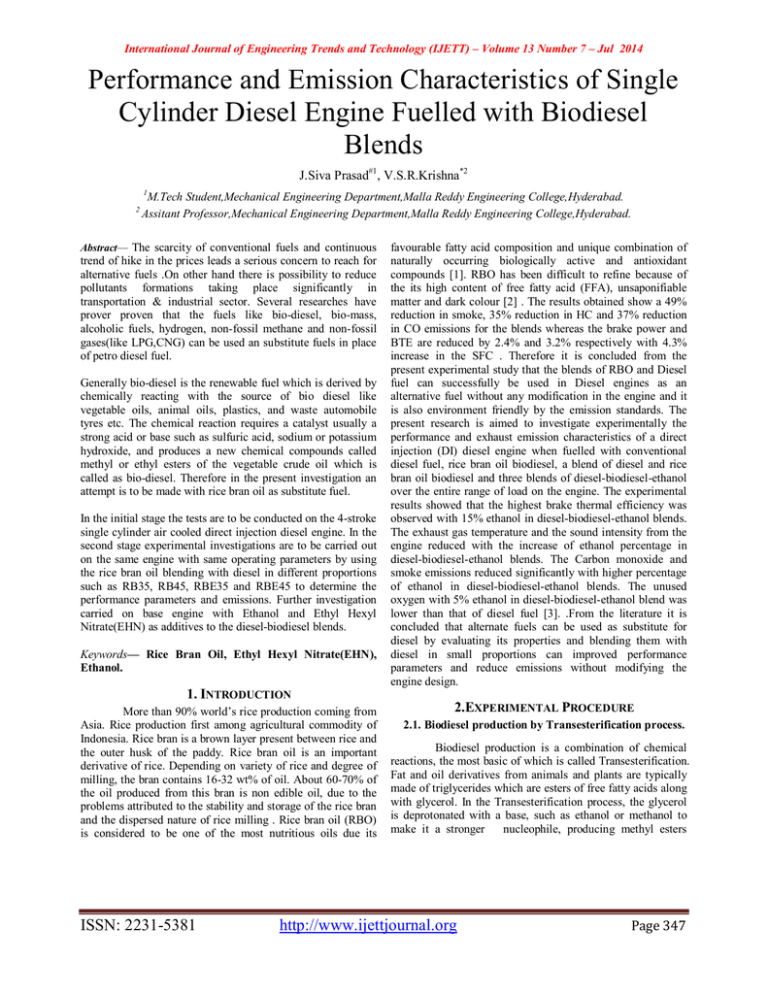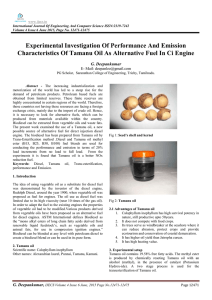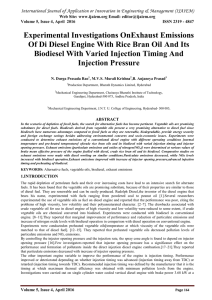Performance and Emission Characteristics of Single Blends
advertisement

International Journal of Engineering Trends and Technology (IJETT) – Volume 13 Number 7 – Jul 2014 Performance and Emission Characteristics of Single Cylinder Diesel Engine Fuelled with Biodiesel Blends J.Siva Prasad#1, V.S.R.Krishna*2 1 2 M.Tech Student,Mechanical Engineering Department,Malla Reddy Engineering College,Hyderabad. Assitant Professor,Mechanical Engineering Department,Malla Reddy Engineering College,Hyderabad. Abstract— The scarcity of conventional fuels and continuous trend of hike in the prices leads a serious concern to reach for alternative fuels .On other hand there is possibility to reduce pollutants formations taking place significantly in transportation & industrial sector. Several researches have prover proven that the fuels like bio-diesel, bio-mass, alcoholic fuels, hydrogen, non-fossil methane and non-fossil gases(like LPG,CNG) can be used an substitute fuels in place of petro diesel fuel. Generally bio-diesel is the renewable fuel which is derived by chemically reacting with the source of bio diesel like vegetable oils, animal oils, plastics, and waste automobile tyres etc. The chemical reaction requires a catalyst usually a strong acid or base such as sulfuric acid, sodium or potassium hydroxide, and produces a new chemical compounds called methyl or ethyl esters of the vegetable crude oil which is called as bio-diesel. Therefore in the present investigation an attempt is to be made with rice bran oil as substitute fuel. In the initial stage the tests are to be conducted on the 4-stroke single cylinder air cooled direct injection diesel engine. In the second stage experimental investigations are to be carried out on the same engine with same operating parameters by using the rice bran oil blending with diesel in different proportions such as RB35, RB45, RBE35 and RBE45 to determine the performance parameters and emissions. Further investigation carried on base engine with Ethanol and Ethyl Hexyl Nitrate(EHN) as additives to the diesel-biodiesel blends. Keywords— Rice Bran Oil, Ethyl Hexyl Nitrate(EHN), Ethanol. 1. INTRODUCTION More than 90% world’s rice production coming from Asia. Rice production first among agricultural commodity of Indonesia. Rice bran is a brown layer present between rice and the outer husk of the paddy. Rice bran oil is an important derivative of rice. Depending on variety of rice and degree of milling, the bran contains 16-32 wt% of oil. About 60-70% of the oil produced from this bran is non edible oil, due to the problems attributed to the stability and storage of the rice bran and the dispersed nature of rice milling . Rice bran oil (RBO) is considered to be one of the most nutritious oils due its ISSN: 2231-5381 favourable fatty acid composition and unique combination of naturally occurring biologically active and antioxidant compounds [1]. RBO has been difficult to refine because of the its high content of free fatty acid (FFA), unsaponifiable matter and dark colour [2] . The results obtained show a 49% reduction in smoke, 35% reduction in HC and 37% reduction in CO emissions for the blends whereas the brake power and BTE are reduced by 2.4% and 3.2% respectively with 4.3% increase in the SFC . Therefore it is concluded from the present experimental study that the blends of RBO and Diesel fuel can successfully be used in Diesel engines as an alternative fuel without any modification in the engine and it is also environment friendly by the emission standards. The present research is aimed to investigate experimentally the performance and exhaust emission characteristics of a direct injection (DI) diesel engine when fuelled with conventional diesel fuel, rice bran oil biodiesel, a blend of diesel and rice bran oil biodiesel and three blends of diesel-biodiesel-ethanol over the entire range of load on the engine. The experimental results showed that the highest brake thermal efficiency was observed with 15% ethanol in diesel-biodiesel-ethanol blends. The exhaust gas temperature and the sound intensity from the engine reduced with the increase of ethanol percentage in diesel-biodiesel-ethanol blends. The Carbon monoxide and smoke emissions reduced significantly with higher percentage of ethanol in diesel-biodiesel-ethanol blends. The unused oxygen with 5% ethanol in diesel-biodiesel-ethanol blend was lower than that of diesel fuel [3]. .From the literature it is concluded that alternate fuels can be used as substitute for diesel by evaluating its properties and blending them with diesel in small proportions can improved performance parameters and reduce emissions without modifying the engine design. 2.EXPERIMENTAL PROCEDURE 2.1. Biodiesel production by Transesterification process. Biodiesel production is a combination of chemical reactions, the most basic of which is called Transesterification. Fat and oil derivatives from animals and plants are typically made of triglycerides which are esters of free fatty acids along with glycerol. In the Transesterification process, the glycerol is deprotonated with a base, such as ethanol or methanol to make it a stronger nucleophile, producing methyl esters http://www.ijettjournal.org Page 347 International Journal of Engineering Trends and Technology (IJETT) – Volume 13 Number 7 – Jul 2014 (biodiesel) in the process. Heat and a catalyst are used to help the reaction proceed more quickly. Rice bran was used as the raw oil to be transesterified with methanol in a reacting tank. The temperature values are below the boiling point of methanol (630C), to prevent the methanol in the reactant mixture from evaporating. The calcium oxide was stirred with methanol for 10 minutes using an electric-magnetic stirrer to form calcium methoxide, which was then poured into the reacting tank and mixed with the Rice bran. The total reaction time was 60 minutes. Almost total conversion to corn oil bio diesel was achieved quickly after a few minutes from the start of the reaction, depending on the ambient conditions. 2.2. Preparation of Biodiesel Blends. After production the RBO was blended with neat diesel fuel in various volume concentrations to prepare biodiesel blends. These blends were subsequently used in the engine tests. The level of blending for convenience is referred as RBXX. Where XX indicates the percentage of biodiesel present in the blend. For example a RB35 blend is prepared with 35% biodiesel and 65% diesel oil by volume.During the present engine experiments the blends prepared and used were RB35, RB45, RBE35 and RBE45. 2.3.Properties of biodiesel comparision with diesel. The test fuels used in the engine during the experiments were RB35, RB45, RBE35, RBE45 and Diesel oil. Before application on the engine, various physicochemical properties of all the above test fuels were determined and compared to each other. Properties Density at150c (gm/cc) Viscosity at 400c (Centi stokes) Cloud point (0C) Pour point (0C) Carbon Residue (%) Calorific value ( KJ/kg) Rice bran oil 0.91 6.1 Pure diesel 6 -3 -6 3 0.42 37850.8 0.1 42,500 0.82 5 3.Experimental Setup The experimental setup shown in figure is a single cylinder four stroke naturally aspirated diesel engine The setup is provided with necessary instruments like Rope brake dynamometer, Smoke meter(Netel’s-NPM-DSM),Gas analyzer(Netel’s-NPM-MGA-2),etc.,for performance and emission analysis. The Specifications of the test engine is shown in given below. ISSN: 2231-5381 3.1 Specifications of Engine Type of Engine Rated power Rated speed Bore dia Stroke length Compression ratio Four stroke single cylinder vertical air cooled diesel engine 4.4kw 1500 rpm 87.5 mm 100 mm 17.5 4.Results and Discussions The experiments are conducted on the four stroke single cylinder water cooled diesel engine at constant speed (1500 rpm) with varying loads with diesel and different blends of Rice bran oil like RB35,RB45,RBE35 and RBE45. Various performance parameters such as brake thermal efficiency, mechanical efficiency, indicated thermal efficiency, brake specific fuel consumption, indicated power and emission parameters in the sense of unburned hydrocarbons, carbon monoxide, carbon dioxide and oxides of nitrogen are discussed below. 4.1 Brake Thermal Efficiency The variation of brake thermal efficiency with brake power is shown in Fig. 6.1. From the plot it is observed that as load increases brake thermal efficiency is also increases for diesel as well as the blends of rice bran oil. At full load condition, the brake thermal efficiencies are obtained 24.25%, 24.12%, 27.12%, 28.10%,and 23.12%for fuels of diesel,RB35,RB45,RBE35 andRBE45 respectively. Among the six blends of Rice bran oil the maximum BTE is 28.10% which is obtained for RBE35. The BTE of Rice bran oil is increases up to 4.10% as compared with diesel at full load condition. The increment in brake thermal efficiency is due to the better combustion because of high calorific value and less viscosity of the Rice bran oil http://www.ijettjournal.org Page 348 International Journal of Engineering Trends and Technology (IJETT) – Volume 13 Number 7 – Jul 2014 25 20 RB35 15 RB45 10 RBE35 5 RBE45 0 DIESEL 0.6 1.17 2.3 3.37 4.39 MECHANICAL EFFICIENCY(%) BRAKE THERMAL EFFICIENCY(%) 30 100 90 80 70 60 RB35 RB45 50 40 30 20 10 BP (KW) RBE35 RBE45 DIESEL 0.6 1.17 2.3 3.37 4.39 BP (KW) 4.2 Indicated Power The variation of indicated power with brake power is shown in Fig 6.4. The plot it is reveals that as the load increases the indicated power decreases. At full load condition the Indicated Power obtained are 6.15 kw,5.99 kw, 4.59 kw,4.33 kw, and 7.70 kw for fuels of diesel, RB35,RB45,RBE35 and RBE45 respectively. The Indicated Power of rice bran oil blend RB25 is decreases with compared to diesel at full load condition. 10 RB35 6 RB45 4 The variation of CO emission with brake power is shown in Fig 6.5. The plot it is observed that is interesting to note that the engine emits more CO for diesel as compared to biodiesel blends under all loading conditions. At full load condition the CO emission obtained are 0.61%, 0.77%, 0.62%, 0.59% and 0.07% for fuels of diesel RB35, RB45, RBE35 and RBE45 respectively. The CO concentration is decreases for the blends of RBE35 with compared to diesel and all other blends. At lower rice bran oil concentration, the oxygen present in the biodiesel aids for complete combustion. However as the rice bran oil concentration increases, the negative effect due to viscosity and small increase in specific gravity suppresses the complete combustion process, which produces small amount of CO. RBE35 2 RBE45 0 DIESEL 0.6 1.17 2.3 3.3 4.3 BP (KW) 4.3 Mechanical Efficiency The variation of mechanical efficiency with brake power is shown in Fig. 6.2.From the plot it is observed as load increases mechanical efficiency is also increases for diesel as well as the blends of rice bran oil. At full load condition the mechanical efficiencies obtained 71.48%, 73.34%, 67.43%, 79.76% and 57.09% for fuels of diesel RB35,RB45,RBE35 and RBE45 respectively. From the above results the mechanical efficiency of Rice bran blend RBE35 increases with compared diesel at full load condition. ISSN: 2231-5381 1 0.8 CO(%) IP(KW) 8 4.4 Carbon Monoxide (CO) Emissions RB35 0.6 RB45 0.4 RBE35 0.2 RBE45 0 DIESEL 0.6 1.17 2.3 3.37 4.39 BP (KW) 4.5 Carbon Dioxide (C02) Emissions The variation of carbon dioxide with brake power is shown in Fig 6.6. The plot is revels that as the the load increases theCO2 emission decreases. At full load condition the CO2 emissions obtained are7.7%,7.5%,6.9%, 5.3% and http://www.ijettjournal.org Page 349 International Journal of Engineering Trends and Technology (IJETT) – Volume 13 Number 7 – Jul 2014 10 CO2(%) 8 RB35 6 4 RB35 40 30 RB45 20 RBE35 10 0.6 1.17 2.3 3.37 4.39 BP (KW) RB45 RBE35 2 RBE45 0 DIESEL 0.6 1.17 2.3 3.3 4.3 BP (KW) 4.6 Oxides of Nitrogen (NOx) Emissions The variation of NOx emission with brake power is shown in Fig 6.8.the plot it is reveals that as the the load increases the NOx emission decreases. At full load condition the NOx emissions obtained are 579ppm, 541ppm, 783ppm, 530ppm and 971ppmfor fuels of diesel RB35, RB45, RBE35 and RBE45 respectively. The NOx emission ofRice bran oil blend RBE35 decreased when compared to the other blends at full load condition. 1000 800 NOX(PPM) 50 HC(PPM) 7.9% for fuels of diesel RB35, RB45, RBE35 and RBE45respectively. The CO2 emissions of rice bran oil blend RBE25 decreased when compared to the diesel at full load condition. RB35 600 RB45 400 RBE35 200 RBE45 0 0.6 1.17 2.3 3.3 4.3 DIESEL BP (KW) 4.7 Unburned Hydrocarbon (HC) Emissions The variation of HC emission with brake power is shown in Fig 6.9. The plot it is observed that the load increases the HC emission decreases. At full load condition the unburned hydrocarbons are obtained are 42ppm, 38ppm, 37ppm, 19ppm and 47ppm, for fuels of diesel, RB35, RB45, RBE35 and RBE45 respectively. The HC emission of rice bran oil blend RB20 decreased when compared to the diesel at full load condition. ISSN: 2231-5381 5 CONCLUSIONS The conclusions derived from present experimental investigations to evaluate performance and emission characteristics on four stroke single cylinder diesel engine fueled with diesel RBOblends with Ethanol and EHN as additives are summarized as follows. Brake thermal efficiency increased with all blends when compared to the conventional diesel fuel. The Brake specific fuel consumption is decreased with the blends when compared to diesel. CO,CO2 and HC emissions are decreased significantly with the blends when compared with diesel. From the above analysis the blend RBE35 shows the better performance compared to other blends(RB35, RB45, ,RBE45) and diesel REFERENCES [1]. RamPrakash, S.P.Pandey,S.Chatterji, S.N. Singh,” Emission Analysis of CI Engine Using Rice Bran Oil and their Esters”. JERS/Vol.II/ Issue I/2011, pp.173-178. [2]. B.K.Venkanna, C. Venkataramana Reddy, Swati B Wadawadagi, “Performance, Emission and Combustion Characteristics of Direct Injection Diesel Engine Running on Rice Bran Oil / Diesel Fuel Blend”. International Journal of Chemical and Bio molecular Engineering vol 2, No.3, 2009. [3]. Chandan Kumar, Gajendra Babu MK, Das LM. Experimental investigations on a Karanja oil ester fueled DI diesel engine. SAE Paper No. 2006-01-0238; 2006. p.117–24. [4]. Ramadhas AS, Muraleedharan C, Jayaraj S. Performance and emission evaluation of a diesel engine fueled with methyl esters of rubber seed oil. Renewable Energy 2005;30:1789–800. [5]. Rukmini, C., and T.C. Raghuram, J. Am. Coll. Nutr. 10: 593-597 (1991). Bhattacharyya, D.K., M.M. Chakrabarty, R.S. Vaidyanathan, A.C Bhatachryya, J. Am. Oil Chem. Soc,60: 467471 (1983). [6]. Goffman, F.D., S. Pinson, and C. Bergman, Genetic diversity for Lipid Content and Fatty Acid Profilein Rice Bran, J. Am. Oil Chem. Soc. 80: 485-490 (2003). [7]. Rogers, E.J., S.M. Rice, R.J. Nicolosi, D.R. Carpenter, C.A. Mc Clelland, and L. J. Romanczyk, J.Am. Oil Chem. Soc. 70: 301-305 (1993). [8]. Puhan Sukumar, Vedaraman N, Sankaranarayanan G, Bharat Ram Boppana V. Performance and emission study of Mahua oil (Madhuca indica oil) ethyl ester in a 4-stroke natural aspirated direct injection diesel engine. Renewable Energy 2005;30:1269– 78. [9]. Hargrove, K.L., Processing and Utilization of Rice Bran in the United States, in Rice Science andTechnology, edited by W.E. Marshall and J.I. Wadsworth, Marcel Dekker, New York, 1993, pp.381-404. http://www.ijettjournal.org Page 350

